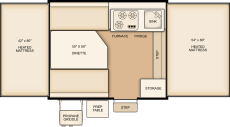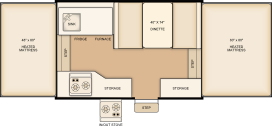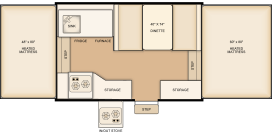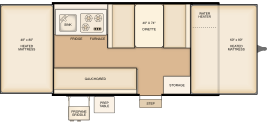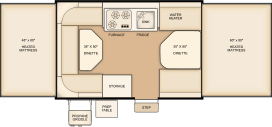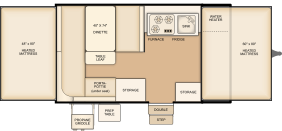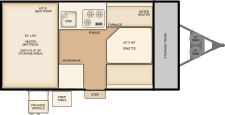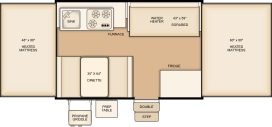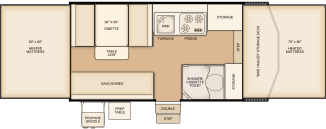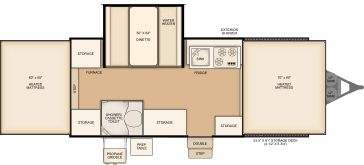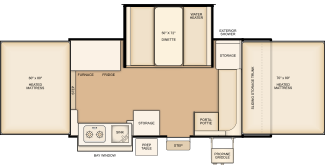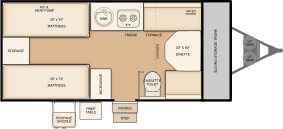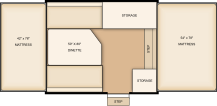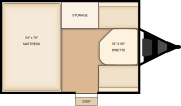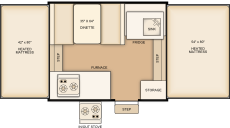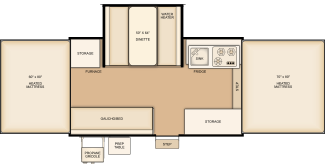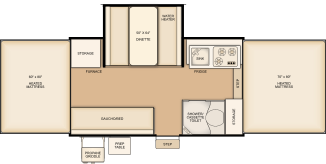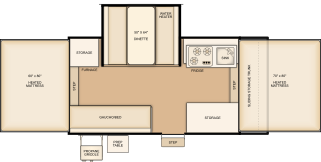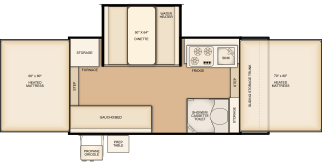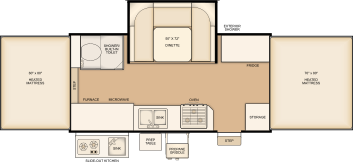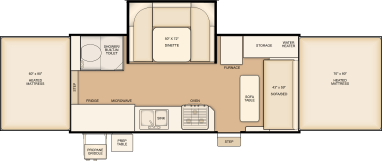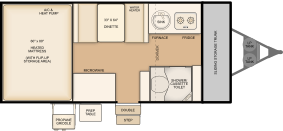Our Thoughts
Unvarnished opinions of Flagstaff's fold-down models
Wouldn't it be nice if every store gave you their honest opinion about what they sell instead of the usual sales pitch? Well, we think so. So here it is:
We break down Flagstaff's models into three categories. The first batch are all-around great campers that work well for almost everybody. The second list contains campers that are more specialized in their features and fit the needs of a smaller group of people. Campers in the last column contain at least one design issue that make them fit a smaller niche.
More Specialized
Also available: Our Thoughts on Discontinued Models
Note: If you read this list straight-through you'll find some repetitive information for similar models or similar features. Sorry for the repetition, but since somebody might jump directly to a particular model and not read all of this we don't want them to be lost and have to back-track. Thanks for reading!
All Around Great Campers
The 176 is light, easy to tow and maneuver, and is a MAC (so it has a 20-gallon water tank, four stabilizing jacks, full-perimeter door, valance, & exterior grill). It also has the largest dinette of any Flagstaff pop-up camper (including the High Wall Series). Six people can sit at the dinette!
In our humble-but-awesome opinion the 176 has a much better layout and better features compared to the 176LTD (please see the 176LTD entry for more information as to why). That's why even though it was technically discontinued in 2010, we ask Flagstaff to make a special batch of them for us every year.
The 206LTD layout (or a version of it like the regular 206 from the '90's or the Starcraft Starflyer from the '80's) has been around for decades and it's not surprising why: it's a light-weight camper with a well-sized dinette, a full walk-way from end to end, lots of storage space and counter space, and a galley with plenty of room to work. This is the best "basic" camper Flagstaff builds.
We take a 206LTD and install a few items (like front stabilizing jacks, an overhead cabinet, and a roof valance) to make it even better. Since it's not a full MAC series camper but it's no longer an LTD unit we give it our own series name, "LT," and simply call it the 206LT.
For a light and easy-to-use camper that has the most helpful features pop-ups offer (a good furnace, well-sized dinette, easy access to the beds, decent storage and counter space), there's nothing better than the venerable 206LT.
Similar to the 207SE but with the dinette and gaucho/bed in opposite corners, a front storage trunk, and in the MAC series. The dinette and galley layout is also similar to the 206LTD. The full walkway from front to back is nice, as is the storage space. The galley has good space to work in. All around a great camper and a nice MAC alternative to its Sports Enthusiast cousins, the 206STSE and 207SE.
For maximum seating and sleeping capacity in a small (10') package there's no comparison to the 208. It's the only Flagstaff model with four 80" long beds. The drawback is that putting both dinettes across the width of the camper means you have to crawl over a bed or dinette to get to the end beds. If you don't need all four beds one or both of the dinette tables can be removed to provide easier access to the end beds.
This is a great layout. The galley has lots of floor space for meal prep or clean-up. The "J dinette" can seat 5 or 6 people but doesn't block the rear bunk the way a full end-dinette would. The storage trunk provides a nice bit of extra storage.
The 206STSE also has the big tires, stereo, roof rack, and cool color scheme of the Sports Enthusiast series. It's a great camper for heading off the beaten path.
The is the efficient T12RB interior with a storage trunk on the front. It adds only 70 lbs. to the weight of the trailer and offers a big box of storage space on the front. The front dinette and rear bunk dinette layout is highly functional. It must be popular, too, because this is the third variant based on the T12RB!
Campers with a more specialized purpose
The idea is to have a 10' box with two separate seating areas plus a walkway that goes from end to end. In theory this is good but in practice the 207SE has some issues:
1. The dinette is only a 64-incher and the wheel well cover takes up a lot of space in the dinette's leg area. The sofa is 62" long. When folded into beds anybody taller than 5' 2" might have a tight squeeze.
2. Because the seating areas are at diagonal ends of the camper the galley is split into diagonal corners as well; the fridge is on the opposite corner from the sink and stove. If two people are sitting on the couch and somebody else is trying to cook dinner and needs something from the fridge then one person on the couch must angle their legs to make a path through that bottleneck.
If the gaucho is needed as a bed (for people shorter than 5' 2") the bottleneck problem becomes even worse. With the gaucho as a bed, anybody going from the back bed, dinette, or galley area to the front bed, fridge, or door have to step over the gaucho bed corner.
I suppose this layout would work with one or two people but it seems like a hassle for larger groups. If two separate seating areas is the goal the the 208 and the 2024 version of the 206M does a much better job. If someone wants the Sports Enthusiast package in a 10' box, we recommend the 206STSE. If the storage trunk on the front of the 206STSE or the lack of a fourth bed is a deal-breaker and high ground clearance is a must, the 207SE could work (or we could take a 208 and add a raise frame and 15" wheels to get close to the Sports Enthusiast ground clearance).
Great floorplan, great features, but the interior shower/cassette is not to everybody's liking. Sometimes a Porta-Pottie that's not bolted in place is a better alternative (and can be taken outside during the day, like out to the bushes or at least into a screen-room or other enclosure, and brought in at night).
The (2023 and prior) non-interior-shower version of the 228BHSE has a cabinet and counter-top where the shower/toilet cassette goes in the 228BHSE (with shower version), and offers a hot water package option that includes an exterior shower which might be a good compromise. (Update 8-2023: starting with the 2024 model year, the interior shower/cassette toilet is now standard on the 228BHSE.)
The 23SCSE has an interior shower/cassette toilet which only appeals to some of the campers out there but it also has a 4 1/2' deck on the front for hauling ATVs, bikes, or other fun toys. Since hauling toys isn't useful to everybody this model qualifies as a "more specialized purpose" camper. Functionally this is a decent layout with many features. One design issue we frown upon: the 64" dinette. For many people a 64" dinette is not comfortable and when it's made into a bed anybody over 5' 2" would need to sleep diagonally.
The 425M has a wide-open floorplan and the front seating area is nice because you can sit down without having to scoot into the slide-out dinette area (plus there's a Porta-Pottie hiding under the front seat). The bay window contributes to the "airy" feel of the layout but the cabinets below the bay window are only half-depth because of it. Overall a nice floorplan with easy access to the whole camper.
It's on the "more specialized" list because the slide-out dinette and bay window add extra steps to the set-up and tear-down to gain extra floor space. It's roomy but not everyone needs that much floor space.
This is a 14' High Wall T-series camper with three separate beds (two twin beds and a dinette that folds into a third bed). It also comes with an extra bed piece that spans across the two twin beds to create the largest bed of any Flagstaff pop-up camper (the combined bed measures 80" x 74").
In theory this should be on the "All Around Great" list, but the odd placement of a cassette toilet right next to the dinette--which also forces the dinette into a strange three-person/half-table configuration--places the T21TBHW squarely in the "Specialized" category.
If Flagstaff had gone with a standard dinette here with a portable toilet underneath the seat, we would happily put it in the "All Around Great" category. (Update 11-2017: They did, sort of--the T21TBHWSE takes our suggestion of a standard dinette and a portable toilet, except in the Sports Enthusiast trim with a gray exterior, a raised frame, and 15" mud tires. Update 11-2019: Sadly, the T21TBHWSE was discontinued along with all SE T-series campers.)
One other note: in 2018 Flagstaff added a dormer to the front of this model. We're not excited about the extra weight, set-up steps, or $$ the dormer entails, especially given the modest 6' 4 " clearance it provides. It does provide a room-ier feel to the camper and a glass front window, though.
Campers That Fit A Certain Niche
We love the 176ED layout, but removing the furnace is one step too far in Colorado, in our experience. For people accustomed to tent camping, this might be ideal. If you already have a camp stove and water basin or water tank setup for washing hands and dishes, you might not need those systems. And it's possible if you're camping where they have power, a space heater will be plenty good in the mountains. Still, the "bed on wheels" has been a tough sell in the past.
Having a place to store your camping supplies that also has beds and can be attached to your tow vehicle at a moment's notice and--off you go to the mountains-- is cool, your camping gear is already packed! But Flagstaff tried a stripped-down model before, called the 170, and we struggled to sell one copy (and it had a stove and sink, at least). Especially when a camper with all the usual systems and just a year or two older could be priced the same as a new one of these makes it tough to justify ordering one.
The F17OTG is on the "niche" list for all the reasons the F14OTG (above) is on the "niche" list, but with the added curiosity of no beds on the ends. The idea is one less step during setup (or two, counting both beds) and the weight savings of not having two bunks. But the F17 is 1230 lbs. The F14 is 1281 lbs. Not a huge weight savings.
If all you need is a bed off the ground, this does just that. And pretty much only that. I can see this being a convenient way to get out of the sun and "off the ground", as well as having a place to store your camping supplies that will help you get on the road faster than if you had to pack your vehicle with all your gear any time you want to go camping. But this only sleeps 3 people, which is a niche camper count. Also, Flagstaff tried a camper without a furnace back in 2007 (model 170), and it lasted half a season before being discontinued.
It's good to offer a small 8' camper but the 176LTD has a problem: the dinette. It's a 64-incher to start with but more troubling is the placement of the wheel well. There's no way to move the wheel well location, of course, so the wheel well is simply covered with two boards that protrude into the dinette's leg area by 12" (out of 34" total). The wheel well cover means that only two adults can sit at this dinette (two small children could presumably put their legs on the cover).
If towing capacity demands a 1344 lb. camper this may work for two people or a small family but for only 150 lbs. more the 206LTD (1493 lbs.) is a much better solution.
The 228D is the lightest slide-out dinette camper Flagstaff makes. This is good, but there are a few issues that keep it on the niche list:
1. the slide-out dinette is only 64" long so it might not be comfortable for some people to sit at and when it's folded into a bed (thus anybody over 5' 4 " would have to sleep diagonally).
2. One of the appealing features of the 228 and 228BHSE is that the gaucho/bed is across from the dinette such that meal time or game time can be shared by 6, 7, or maybe even 8 people. With a slide-out dinette this isn't possible (not only are the two seating areas too far apart but the slide-out dinette is elevated 6" to accommodate the slide-out hardware). Two separate areas might be beneficial in certain instances but it decreases the flexibility offered by having the couch and dinette together.
3. The 12' MAC campers are 4" shorter in the sidewall than their Classic counterparts. Why that matters with a slide-out dinette is that the dinette cushions that fold down to make the bed can stay in bed format on the Classic campers, but they have to be moved on the 228D with four less inches of clearance where the end-bunks slide in. The two seat-bottom cushions can fit under the dinette table (though that space on a Classic can be used to store other gear) but the two seat-back cushions have to fit between the slide-out dinette and the gaucho after the slide-out dinette has been pushed in.
Granted, this is a minor irritation, but it's an issue the 228 (if a slide-out dinette is not necessary) and the Classic Series (if a slide-out dinette is necessary) did not have.
This model has the same layout issues as the 228D but with an interior shower/cassette toilet installed in the front door-side corner. The interior shower/cassette toilet is not for everybody; the hot water package with an outside shower (on the 228D) might be an acceptable alternative if you're on the fence about an interior shower/cassette toilet.
The 228SE has an enclosed storage trunk on the front that the 228D does not have. Otherwise, all of our concerns with the 228D are the same for the 228SE, just 4" higher (since it's the Sports Enthusiast model). To recap, here are the issues:
1. the slide-out dinette is only 64" long so it might not be comfortable for some people to sit at and when it's folded into a bed (thus anybody over 5' 4 " would have to sleep diagonally).
2. One of the appealing features of the 228 and 228BHSE is that the gaucho/bed is across from the dinette such that meal time or game time can be shared by 6, 7, or maybe even 8 people. With a slide-out dinette this isn't possible (not only are the two seating areas too far apart but the slide-out dinette is elevated 6" to accommodate the slide-out hardware). Two separate areas might be beneficial in certain instances but it decreases the flexibility offered by having the couch and dinette together.
3. The 12' MAC campers are 4" shorter in the sidewall than their Classic counterparts. Why that matters with a slide-out dinette is that the dinette cushions that fold down to make the bed can stay in bed format on the Classic campers, but they have to be moved on the 228D with four less inches of clearance where the end-bunks slide in. The two seat-bottom cushions can fit under the dinette table (though that space on a Classic can be used to store other gear) but the two seat-back cushions have to fit between the slide-out dinette and the gaucho after the slide-out dinette has been pushed in.
This model has the same layout issues as the 228SE but with an interior shower/cassette toilet installed in the front door-side corner. The interior shower/cassette toilet is not for everybody; the hot water package with an outside shower (on the 228SE) might be an acceptable alternative if you're on the fence about an interior shower/cassette toilet.
KS stands for "Kitchen Slide" and means that a mini-galley with sink and stove slides out of the side of the camper so you can wash and cook outdoors. Although there are times when a sink on the outside of a camper would be handy, the amount of space that the slide mechanism takes up and the added weight to the trailer (150 lbs--for that?) seems like a bad trade-off.
If cooking and washing hands on the outside of the camper is vital, we'd recommend the lighter, less expensive, and simpler HW27SC* which has a grill on the outside and an exterior shower for hand-washing.
Second, the wrap-around dinette is less useful than a regular dinette (please see Not All Dinettes Are Created Equal). Taken as a whole, we believe the HW27SC is superior to the HW27KS in every aspect except the "Is The Sink Outside?" category.
(*The HW27SC was discontinued in 2019. If a High Wall camper is a must, we'd recommend looking for a used HW27SC.)
Lastly, the placement of the step is a big problem. The step on the HW27KS is 2 1/2' closer to the front of the trailer than the step on the HW27SC. This has caused many bent steps because the farther away the step is from the tires, the greater the "dip" angle when the tow vehicle goes through low spots on the road. Having a step farther back like on the HW27SC protects the step much better.
(We realize the factory-provided promo pictures above are not at the same angle. Mostly we want to show how the HW27KS's step is just really hanging out there, looking odd and ready to hit speed bumps and other obstacles.)
UPDATE: to fix the "bent step" problem, Flagstaff changed the exterior step to a "stepper door" in 2019 where the step folds up into the camper, so it no longer hangs below the camper during transit. However, this stepper door creates new problems:
1. When the step is down it rests on the ground. If you have a level campground, that's great. If not, even though the leg height is adjustable, the step may not be level because the adjustments "holes" could be between where you need them to be. Also, let's say you get the camper set up and realize you need to move a couple feet in the camping spot to accommodate other things like your tow vehicle, a picnic table, an easy-up screen room, etc. Normally you'd just push the camper where you need it to go. With this step, you'll need an extra person holding the step above the ground. Otherwise you'll need to put the door back into the "up" position and then fold up the step just to move the camper an inch.
2. Did you put a cooler, toolbox, extension cord, etc. in the front compartment by the door or on the floor for easy access during travel or when you set up the camper? Well too bad, because the step is now blocking that entirely when the camper is down. Yes, you can open the door and then bring the step down, so it's just one extra step, right? Well, now the step is in your way so you have to straddle the step or kneel onto the step's grip tape to get whatever you need. "Easy access" isn't possible with this step.
3. With a regular step, if it's muddy or highly dusty at your campground, you slide the step into place when you're ready to leave and then wash off the mud or dirt at a car wash or when you get home. With the stepper door, that mud and dust is going right into the camper when you fold the step up unless you clean it before folding the step into the camper. It's a minor thing, yes, but it's one extra thing that's not necessary with the regular step.
The High Wall campers have higher sidewalls that affect the "feel" of the interior (it feels a bit more closed-off from the outdoors) and that doesn't necessarily work for some people. Also the HW29SC has a wrap-around dinette and that's not always the best way to go when acting as the primary dinette area (please see Not All Dinettes Are Created Equal).
Mostly our problem with this model is the sofa/bed: at the expense of the two extra feet of box space, a second axle, 300+ extra pounds, and a lot more money, the HW29SC provides--essentially--one extra bed over the HW27SC. The problem, though, is that this bed is only 43" x 60". It seems like a lot of extra weight, money, and ungainly-ness for a five-foot bed. For all these reasons we recommend the HW27SC* over the HW29SC.
(*The HW27SC was discontinued in 2019. If a High Wall camper is a must, we'd recommend looking for a used HW27SC.)
UPDATE: In 2019 Flagstaff changed the regular step to the "stepper door", which only adds to the frustration with this model. We have plenty to say about the stepper door in the HW27KS entry above ![]() .
.
This was Flagstaff's first foray into T-series dormers. The dormer was meant to provide a horizontal surface to mount the shower curtain (since the previous method of attaching the shower curtain to the non-dormer, angled roof was with pieces of velcro and an angle-cut shower curtain found in the discontinued T19SCHW). However, the dormer has only 6' 4" of clearance so the shower still leaves a lot to be desired for taller folks. The extra weight, set-up steps, or $$ the dormer entails does not help its case, either.
So the dormer is not ideal, but the main reason the T21DMHW is on the "niche" list involves the dinette. It is a 33" x 64" dinette--the smallest dinette in any Flagstaff pop-up camper. This may work for two smaller people but it will most likely be uncomfortable for anyone over 5' 6" or so. And if a camping trip requires a second bed, the 5' 4" dinette bed may be a limiting factor.
That being said, it's possible this model would be perfect for one or two people who need an interior shower and perhaps if most meals are eaten outdoors the size of the dinette won't matter.
![]() Back to Buyer's Guide
Back to Buyer's Guide
Privacy © 2009-2025 Roberts Sales. All rights reserved.


